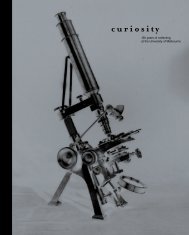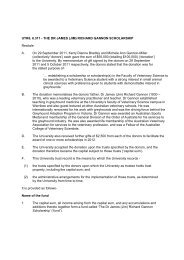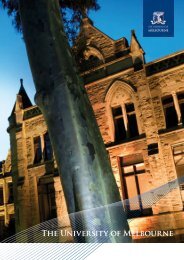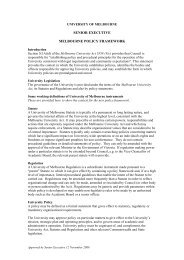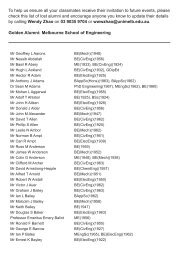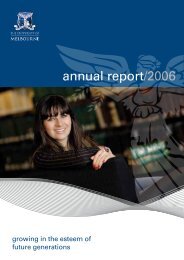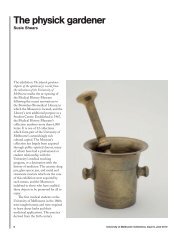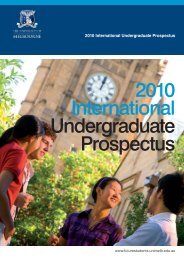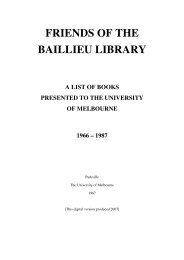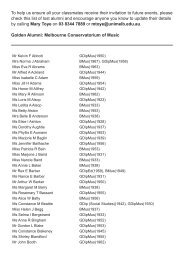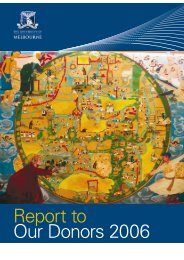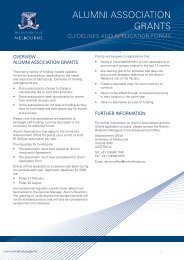2007 Annual report (PDF 8.1 Mb) - University of Melbourne
2007 Annual report (PDF 8.1 Mb) - University of Melbourne
2007 Annual report (PDF 8.1 Mb) - University of Melbourne
Create successful ePaper yourself
Turn your PDF publications into a flip-book with our unique Google optimized e-Paper software.
BINDING THE<br />
stRANDS TOGETHER<br />
<strong>2007</strong> saw the <strong>University</strong>’s marketing<br />
focus on brand and image to promote the<br />
<strong>Melbourne</strong> Model and to communicate<br />
the six New Generation undergraduate<br />
degrees and new courses and pathways to<br />
graduate education.<br />
DreaMlarge<br />
Strategic Priorities<br />
> Launch a high-impact brand advertising<br />
campaign with consistent approach<br />
across all major media and integrate with<br />
<strong>Melbourne</strong> Model launch<br />
> Promote attributes <strong>of</strong> <strong>Melbourne</strong> Model<br />
and <strong>Melbourne</strong> Model graduates to<br />
prospective students, employers and<br />
other external stakeholders through<br />
newsletters, correspondence, road shows<br />
and events<br />
> Coordinate <strong>University</strong> marketing activity<br />
through Marketing and Communications<br />
Reference Group (M&C Reference Group)<br />
Achievements<br />
The <strong>Melbourne</strong> Model was formally<br />
launched to the public in April <strong>2007</strong>, at<br />
a launch structured around explaining to<br />
stakeholders and the media the vision<br />
driving the <strong>University</strong>’s new model for<br />
education. The ‘DreamLarge’ cinema and<br />
television advertising campaign supporting<br />
the introduction <strong>of</strong> the Model was unveiled<br />
at the launch. The campaign stressed the<br />
opportunities opened to all by education,<br />
with each advertisement drawing<br />
on current examples <strong>of</strong> research and<br />
Knowledge Transfer at the <strong>University</strong>.<br />
Introduction <strong>of</strong> the DreamLarge campaign<br />
provided an overarching promotional<br />
platform to tie together course<br />
promotion, recruitment, research and<br />
student scholarship activity. A sustained<br />
multimedia program operated throughout<br />
the year with increased activity around<br />
important public events such as Open Day.<br />
In conjunction with the DreamLarge<br />
campaign, the <strong>University</strong> made significant<br />
advances in branding, merchandising<br />
and signage programs designed. This<br />
was particularly evident on Open Day<br />
with a record crowd <strong>of</strong> more than 60,000<br />
immersed in an atmosphere <strong>of</strong> ‘<strong>University</strong><br />
blue’ and consistent messaging throughout<br />
the campus from banners to the branded<br />
suite <strong>of</strong> marketing publications.<br />
The successful launch <strong>of</strong> the <strong>Melbourne</strong><br />
Model was followed by a process <strong>of</strong> school<br />
visits across the state, with public sessions<br />
and private explanations throughout the<br />
year to ensure all sectors <strong>of</strong> the community<br />
understand the <strong>University</strong>’s new approach.<br />
A range <strong>of</strong> new student recruitment<br />
publications assisted in the process.<br />
Open Day provided an opportunity<br />
to provide detailed information to a<br />
crowd already well-informed about<br />
the broad <strong>Melbourne</strong> Model approach.<br />
Other highlights <strong>of</strong> the <strong>University</strong>’s<br />
communications program were the annual<br />
Town and Gown dinner, the Postgraduate<br />
Expo and the Graduate Schools launch in<br />
October. The M&C Reference Group met<br />
monthly throughout the year to coordinate<br />
marketing activities.<br />
New Media<br />
Strategic Priority<br />
> Develop new digital media including<br />
podcasts and video magazines and<br />
update existing publications, including,<br />
Research Review and the <strong>Melbourne</strong><br />
<strong>University</strong> Magazine to align with the<br />
<strong>University</strong>’s marketing strategy<br />
Achievements<br />
The use <strong>of</strong> the web as a key<br />
communications tool was developed<br />
through internet-based marketing programs<br />
and online communications. A range <strong>of</strong><br />
digital material and DVDs were developed<br />
to promote the <strong>Melbourne</strong> Model while<br />
21 ‘<strong>Melbourne</strong> Upclose’ podcasts and 17<br />
episodes <strong>of</strong> ‘Visions’ web-streamed TV<br />
provided a range <strong>of</strong> content with broad<br />
reach and further syndication to media to<br />
widen the broadcast and distribution <strong>of</strong><br />
<strong>University</strong> content.<br />
The colour tabloid <strong>Melbourne</strong> Voice was<br />
introduced during the year to replace<br />
UniNews in providing a fortnightly review<br />
<strong>of</strong> news, scholarship and events. The<br />
Research Review continued to showcase<br />
the best <strong>of</strong> the <strong>University</strong>’s research and the<br />
<strong>Melbourne</strong> <strong>University</strong> Magazine was sent to<br />
the <strong>University</strong>’s stakeholders including more<br />
than 160,000 alumni around the world. Its<br />
role for future years is under review.<br />
A Marketing Recruitment and Advancement<br />
planning conference was convened to<br />
develop an integrated marketing activity<br />
plan for implementation in 2008. Marketing<br />
in 2008 will focus on the establishment<br />
<strong>of</strong> Graduate Schools and promotion <strong>of</strong><br />
the developments in Graduate Education.<br />
The key feature <strong>of</strong> the 2008 marketing<br />
program will be integration to showcase<br />
all aspects <strong>of</strong> the <strong>University</strong>. Activity in<br />
key interstate and overseas markets will<br />
combine alumni, recruitment, learning and<br />
teaching, research, and knowledge transfer<br />
activities together into concentrated periods<br />
<strong>of</strong> activity.<br />
Infrastructure<br />
Enhance the quality <strong>of</strong><br />
student experience<br />
through improved IT and<br />
physical infrastructure<br />
Ensure that physical<br />
infrastructure is in<br />
plACe which supports<br />
Growing Esteem<br />
Strategic Priorities<br />
> Develop and implement a masterplan<br />
with a view towards enhancing the<br />
<strong>Melbourne</strong> Experience, and providing a<br />
better learning environment, including<br />
learning hubs<br />
> Ensure that learning and teaching capital<br />
works priorities are aligned with the<br />
<strong>University</strong>’s masterplan<br />
> Ensure that the student hub/resource<br />
centre is ready for the introduction <strong>of</strong> the<br />
<strong>Melbourne</strong> Model<br />
> Examine options for the consolidation <strong>of</strong><br />
undergraduate teaching spaces on the<br />
Parkville campus<br />
Achievements<br />
The preparation <strong>of</strong> a new Parkville campus<br />
masterplan to support Growing Esteem is<br />
well advanced. The masterplan process<br />
takes into account the transition to the<br />
<strong>Melbourne</strong> Model as mapped out by the<br />
Curriculum Commission, to support delivery<br />
<strong>of</strong> both New Generation undergraduate<br />
degrees and graduate schools. The final<br />
masterplan will involve ongoing physical<br />
and IT infrastructure projects and will also<br />
incorporate the recommendations <strong>of</strong> the<br />
Information Futures Commission for the<br />
<strong>University</strong>’s information strategy for the<br />
next decade.<br />
A key priority for infrastructure planning is<br />
to make provision for the learning precincts<br />
to support the <strong>Melbourne</strong> Model. The<br />
design rationale for these innovative spaces<br />
is set out on page 41 in the Teaching and<br />
Learning section.<br />
Design and development for the first<br />
learning precinct the – Eastern Precinct<br />
was completed during the year. Project<br />
completion is scheduled for late in 2008,<br />
with a budget <strong>of</strong> $15.5 million.<br />
Refurbishment works were carried out<br />
during the latter part <strong>of</strong> <strong>2007</strong> to create a<br />
Student Learning Centre in the Engineering<br />
Precinct. The project was completed in<br />
late <strong>2007</strong> in time for first semester 2008<br />
at a cost <strong>of</strong> $2.2 million. Design and<br />
development has commenced for the<br />
co-located library/student centre in the<br />
The <strong>University</strong> <strong>of</strong> <strong>Melbourne</strong> <strong>Annual</strong> Report <strong>2007</strong> 61



